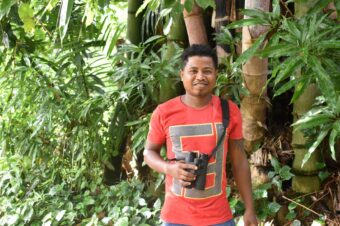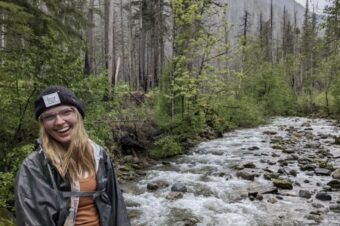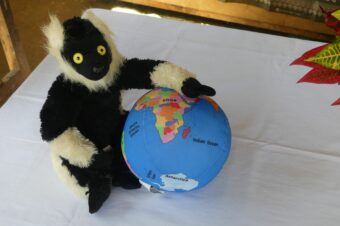Blog by MBP Volunteer, Adam
In my last post I talked about an expedition to Lakia and Simone that MBP invited me on. I didn’t mention that on that same expedition, some people from the village of Analabe, near-by Simone, reported seeing several Milne-Edwards Sifaka’s in the forest of Simone, as many as 10 living in the tangled mass of secondary forest that juts from the mountains steep southern slopes. These large members of the genus Propithicus are all black except for a low dorsal belt of white, and were high on my list of lemurs to see, being found in the not too close not too far Ranomafana Nat’l Park. If the reports of Milne-Edward’s in Simone is true, it would be a critical area for conservation priority. So, once again, MBP invited me to tag along with a darting team to search the same forest I had left only a month before for these animals. On our last expedition we had seen no sign of these ghostly lemurs, and previous expeditions searching for them had come up similarly empty. But the chance of their being there was too great to pass up – it would be critical for their conservation in the region, not to mention the country at large. Under a cool May sky our team headed out, moving southward along a well-worn path from the village of Morarano. Eventually the path became smaller and smaller, until we found ourselves crossing rice paddies, fording rivers and climbing up and up through the hilly region south of Kianjavato, back to the forest of Simone. We returned to our original camping spot along the eastern slope of the mountain, a few minutes climb from the edge of the forest, and from there began the slow and quiet work of combing the mountain Simpana, the Malagasy name for these elusive animals. With every step, over vines and under tree branches, I found myself holding my breath, straining to hear any sign of arboreal activity. If I stepped on a twig my head shot up, afraid I’d spooked our quarry. At one point a passing flock of Blue Coua, large and magnificent dark blue birds, brought my eyes up to full attention in the tree tops as they swooped along, looking for Leaf-Tailed Geckoes. Deeper and deeper into the forest we trekked, passing along logging and game trails, searching for any sound or sight of the animals we so desperately wanted to find. If found, the dart team would carefully tranquilize, process and collar the animal so we could keep track of them for future research.
Along with the darting team, myself and Varecia guide Dakely, our team was also joined by Fredo, community liason at KAFS. Fredo came to speak with the local villages about decreasing the deforestation of Simone and set the stage for future conservation efforts in the region. Through meetings with local village leaders, he was able to explain the value of the forest, the laws about killing lemurs, and educate the people in the areas about conservation of their natural resources. People, while wary at first of these strange outsiders and the odd bearded vazaha with them, were grateful for the information and made promises to stop killing lemurs in the region and begin conserving the forest. Unfortunately in our short time frame we were unable to find any Sifaka in the forest itself. However, this could just mean they are extraordinarily weary of humans and good at hiding, due to the massive hunting pressure on them in the past. Further expeditions are planned to continue the search for these rare and beautiful animals. Personally, I will admit that I am afraid we’ve been chasing ghosts of lemurs past. However I hold out hope that they are still there – it would be incredible not just for the animals living there but the people as well, who could take pride in knowing they play keepers of such a rare and amazing species.In the meantime though, I’m glad I was lucky enough to enjoy the views from our camp and see once again the beauty of this remote region of south-eastern Madagascar.











